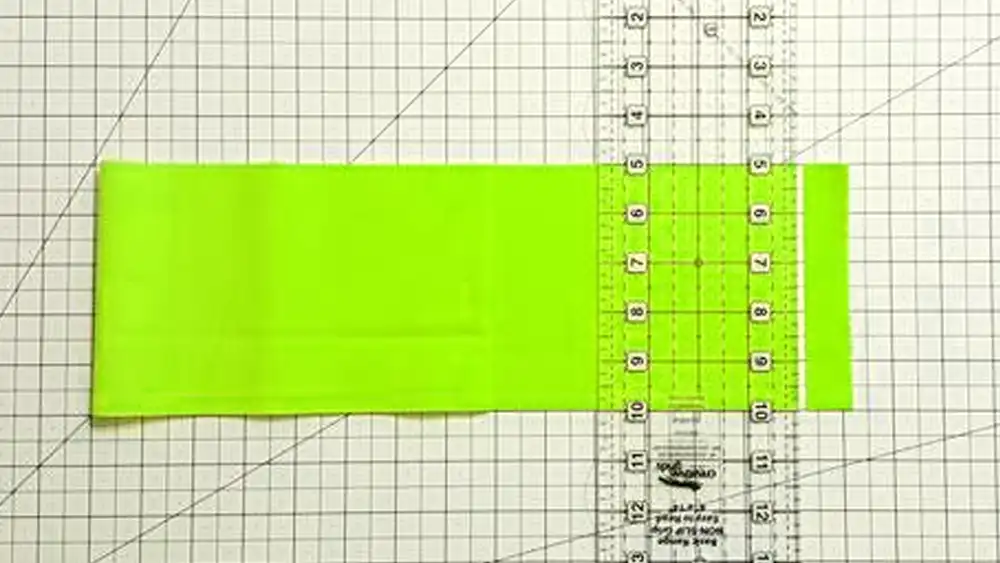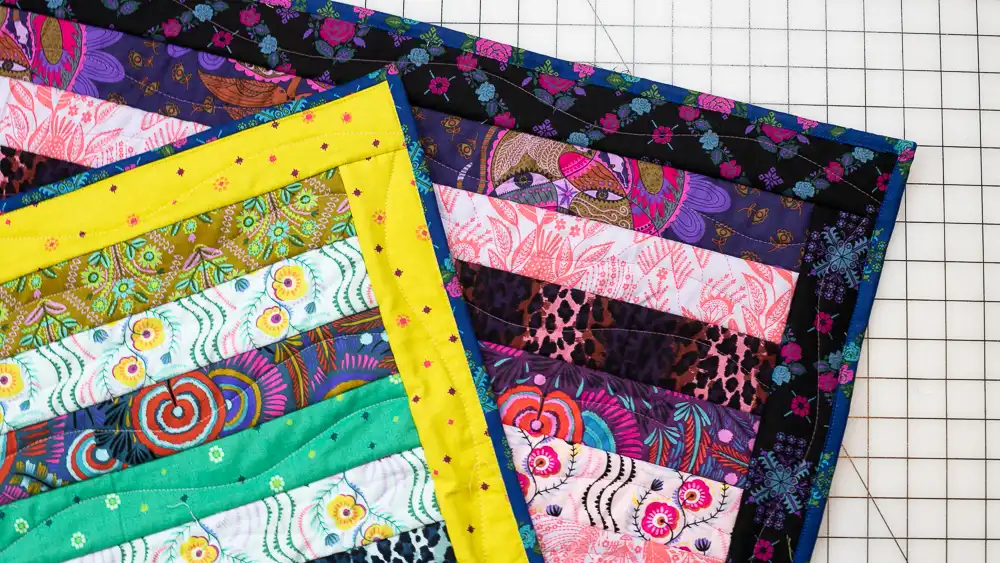When beginning a quilt, the first step is cutting fabric into strips. Today, we’ll explore 3 and a half methods for cutting fabric strips. I say “half” because two of the methods are quite similar. I find all four techniques handy in different situations, so let’s dive into how to cut fabric strips for quilting.
How to Cut Fabric Strips for Quilting

Fabric strips are the foundation of many beautiful quilt designs. However, cutting them perfectly straight and consistent can be tricky. Don’t worry! This guide will take you through the steps of cutting fabric strips for quilting, giving you the tools and confidence to master the task.
Gathering Your Supplies for Cutting Fabric Strips for Quilting
- Sharp Rotary Cutter: Invest in a high-quality rotary cutter (typically 45mm or 60mm) for clean, precise cuts.
- Self-Healing Cutting Mat: Protect your work surface and ensure accurate measurements with a grid.
- Acrylic Ruler: Choose a clear, at least 24-inch long ruler with easy-to-read markings for better control.
- Square: A quilting square is essential for squaring up fabric and ensuring straight lines.
- Fabric Shears (optional): Useful for trimming and finishing details.
- Pins (optional): Help hold fabric layers together for precision when cutting.
Preparing the Fabric:
Pre-wash your fabric: Washing prevents future shrinkage and color bleeding. Follow the care instructions for best results.
Ironing (optional): Ironing smooths out wrinkles, making cutting easier. Skip this for wrinkle-prone or heat-sensitive fabrics.
The Fabric Cutting Process
Two main methods are commonly used to cut fabric strips: the Strip Method and the Rotary Cutting Method. Let’s break them down:
The Strip Method (Beginner-Friendly)
- Measure and Mark: Lay your fabric flat on the cutting mat. Using a ruler and square, measure and mark your desired strip width along the selvedge (finished edge). Repeat at consistent intervals across the fabric. You can use a fabric marking pen or disappearing marker.
- Cut the Strips: Using fabric shears, carefully cut along the marked lines for straight, clean strips.
The Rotary Cutting Method (Efficient and Precise)
- Folding the Fabric: Lay your fabric flat, then fold it lengthwise with the selvedges meeting. Ensure the fold is crisp and the edges align perfectly.
- Position the Ruler: Place your ruler along the fold, aligning the desired strip width with the cut edge.
- Cut with the Rotary Cutter: Grip the rotary cutter with your dominant hand, keeping your wrist straight. Glide the cutter along the ruler, starting from one end and moving toward yourself, applying firm, even pressure throughout.
Tips for Cutting Success
- Sharp Blade: A dull blade can cause jagged edges. Replace your blade regularly to maintain precision.
- Clean Cutting Mat: A cluttered mat can make your ruler slip, leading to inaccurate cuts.
- Good Posture: Stand with relaxed shoulders to avoid strain.
- Quilting Ruler: A quilting ruler has more visible markings than a regular ruler, making it easier to work with.
- Cut Multiple Layers: For thin fabrics, you can pin or clip several layers together and cut them at once. Be cautious with thicker fabrics to avoid dulling the blade.
- Recutting: If you make a mistake, don’t hesitate to recut. Precision is key.
Moving Forward
Once you’re comfortable with the basics, try more advanced techniques like sub-cutting strips (cutting wider strips into narrower ones), diagonal strips for a unique look, or curved strips for appliqué projects.
Organization Is Key
Sort by Size: Keep strips of the same size together to avoid confusion and make piecing easier.
Label Your Strips: Mark the width and quantity of each strip for easy reference during the quilting process.
How to Cut Long Strips of Fabric for Quilting

There are two main methods for cutting long strips of fabric for quilting, each with its own advantages:
Method 1: The Rotary Cutting Method (Efficient)
This method is ideal for cutting multiple strips of the same width quickly and efficiently. Here’s what you’ll need:
- Sharp rotary cutter (45mm or 60mm)
- Self-healing cutting mat (large enough to accommodate your fabric)
- Acrylic ruler (at least 24 inches long, with clear markings)
- Square (optional)
Steps:
- Prepare your fabric: Pre-wash and iron your fabric if needed (refer to care instructions).
- Fold the fabric: Lay your fabric flat on the cutting mat. Fold it in half lengthwise, with the selvedges (finished edges) meeting. Ensure the fold is crisp and the edges align perfectly.
- Position the ruler: Place your ruler along the fold, aligning the desired strip width with the cut edge of the fabric.
- Cutting with the rotary cutter: Hold the rotary cutter in your dominant hand with a firm grip. Keep your wrist straight and your elbow anchored on the cutting mat. Glide the rotary cutter along the ruler, starting from the farthest end and moving towards yourself, applying firm, even pressure throughout the cut.
- Tip: Use a quilting ruler for easier reading of markings from both sides.
Method 2: The Strip Method (Great for Beginners)
This method offers more control over individual strip measurements and is ideal for cutting a smaller number of strips or strips with odd widths. Here’s what you’ll need:
- Fabric shears
- Ruler (at least as long as the desired strip width)
- Square
- Fabric marking pen (optional)
Steps:
- Prepare your fabric: Pre-wash and iron your fabric if needed (refer to care instructions).
- Measure and mark: Lay your fabric flat on the cutting mat. Using a ruler and square, measure and mark the desired strip width along the selvedge (finished edge) of the fabric. Repeat at consistent intervals across the width of the fabric. You can use a fabric marking pen or a disappearing marking tool.
- Cutting the strips: Using fabric shears, carefully cut along the marked lines, aiming for straight, clean cuts.
Tips for Cutting Long Strips:
- Sharp blade: A dull blade tears fabric and creates uneven strips. Replace your blade regularly for optimal performance.
- Clean cutting mat: A cluttered mat can cause the ruler to slip and lead to inaccurate cuts.
- Maintain good posture: Stand with good posture and keep your shoulders relaxed to avoid back strain.
- Cutting multiple layers: If your fabric is thin and allows, you can pin or clip several layers together and cut them simultaneously using the rotary cutting method (be cautious with thicker fabrics to avoid dulling the blade). This saves time when you need many strips.
- Don’t be afraid to recut: If you make a mistake, it’s better to recut a strip accurately than try to salvage an imperfect one. Remember, precision matters!
Additional Considerations:
- Length of strips: Ensure your cutting mat and ruler are long enough to accommodate the entire length of the strips you need.
- Fabric width: Consider the width of your fabric in relation to the desired strip width. You may need to adjust your cutting strategy if the fabric isn’t wide enough for multiple strips.
By following these steps and practicing good technique, you’ll be a pro at cutting long strips of fabric for your quilting projects in no time!
How to Make a Quilt With Strips of Fabric

Here’s a breakdown on how to make a quilt with strips of fabric, also known as strip piecing:
Materials:
- Fabric strips (cut using the methods from previous guides!) – Choose a variety of colors and patterns for a vibrant quilt, or stick to a cohesive color palette for a more classic look.
- Fabric for backing (enough to cover your quilt top)
- Batting (insulating layer between the quilt top and backing) – Choose the thickness based on your desired warmth.
- Sewing machine with a walking foot (optional, but recommended for even feeding of fabric strips)
- Thread in colors that complement your fabrics
- Rotary cutter, ruler, cutting mat (optional, if you haven’t cut your strips yet)
- Fabric shears
- Sewing pins or clips
- Iron and ironing board
Steps about Making a Quilt with Fabric Strips:
- Plan your design: Sketch or lay out your strips to visualize the overall look of your quilt. Consider factors like strip width, color placement, and any specific patterns you want to create. There are many resources online and in quilting books for strip piecing inspiration.
- Sew strips into units (optional): This step is not mandatory but allows for more complex patterns. You can sew strips together in various ways, like squares, rectangles, triangles, or even log cabin style.
- Assemble the quilt top: Sew your pieced units (or individual strips) together in rows. Here are some popular strip piecing techniques:
- Simple straight rows: This is a beginner-friendly option where you sew strips together in alternating colors or patterns to create rows.
- Offset rows: Shift the starting point of each row by half a strip width for a more dynamic look.
- Pinwheel blocks: Create pinwheel patterns by sewing strips together in a specific configuration.
- Join the rows: Sew the completed rows together to form your quilt top. Ensure your seams match up carefully for a professional finish. Press your seams open after each step for a flat surface.
- Prepare the backing and batting: Layer the batting on a large flat surface, then lay your quilt top over the batting, followed by the backing fabric. Ensure all layers lie flat and square. You can use safety pins or basting spray to temporarily hold the layers together.
- Quilting (optional): This step involves stitching through all three layers (top, batting, backing) to create a finished quilt. You can quilt simple straight lines, geometric patterns, or more elaborate designs. You can hand-quilt or machine-quilt depending on your preference and skill level.
- Binding: Create a finished edge for your quilt by binding it with fabric strips. There are various binding techniques, but the basic idea involves sewing a long strip of fabric around the raw edges of your quilt, folding it over for a neat finish.
Tips:
- Wash and pre-shrink your fabrics: This prevents shrinkage and color bleeding after you’ve finished your quilt.
- Use a walking foot: This helps ensure the fabric strips feed evenly through the sewing machine, preventing puckering or uneven seams.
- Press your seams: Pressing seams open after each step helps create a flat and professional-looking quilt top.
- Start small: For your first strip piecing project, consider making a small throw quilt or wall hanging to practice your techniques and gain confidence.
With careful planning, some practice cutting strips, and these assembly steps, you’ll be well on your way to creating a beautiful and unique quilt using the art of strip piecing!
Conclusion
In conclusion, conquering the art of cutting fabric strips unlocks a world of creative possibilities for your quilting endeavors. This guide has equipped you with the knowledge and techniques to tackle both the strip method and the rotary cutting method, empowering you to achieve perfectly straight and consistent strips for your projects.
Remember, precision is key, so don’t be afraid to experiment and find the technique that works best for you.
Beyond the basics, we explored advanced cutting techniques and organizational tips to streamline your workflow. Now, armed with these valuable skills, you can confidently embark on creating stunning quilts using strips of fabric. So, grab your favorite fabrics, sharpen your rotary cutter, and get ready to unleash your inner quilting artist! Happy cutting, and happy quilting!
